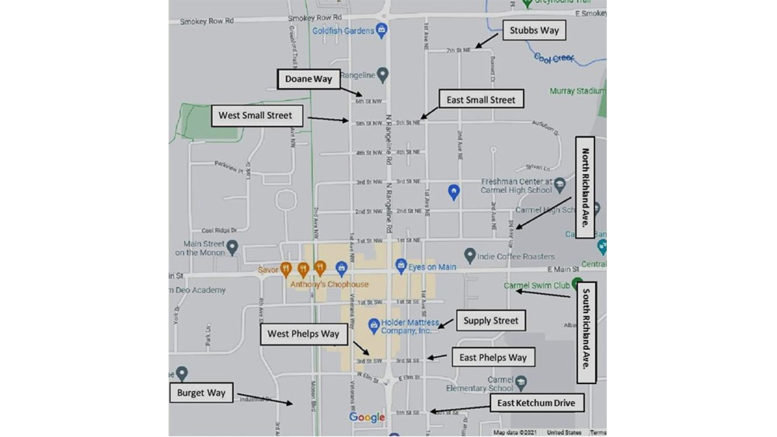In an effort to reduce what Carmel city officials call “confusion about Carmel’s traditional numbered and directional street names,” the city has announced another round of changes with a nod toward historical figures. The research into these notable historical figures was complied by the Carmel Clay Historical Society.
Letters were sent last year to residents and businesses impacted by the street name changes, which take effect Feb. 1.
Below is some history about Carmel’s notable ancestors:
Stubbs Way
Bill Stubbs was a track star at Carmel High School from 1947 to 1950. Sportswriters tried out several nicknames for him – the Carmel Meteor, Blazing Bill, Bullet Bill, and Carmel’s One-Man Track Team, but the one that stuck was the Carmel Comet.
Stubbs was a star, and crowds showed up wherever he ran, hoping to see him break a record. By the time he graduated, he held school and Hamilton County records in the 100- and 220-yard dashes as well as the long jump. He also held the Sectional record for the 220-yard dash and the Regional record for both dashes. He posted the state’s best time in both of the dashes his sophomore, junior and senior year and earned national recognition for running the second fastest 100-yard dash in the country in 1949.
Stubbs did all of this on sheer talent alone. He ran for three coaches in four years, none of whom had a background in the sport, and trained on grass because Carmel did not have a track.
Doane Way
Minnie Doane joined the Women’s Army Auxiliary Corps in 1942. She served in General MacArthur’s headquarters in Australia, New Guinea, and the Philippines. Her three years overseas was the only time in her life she lived outside of Carmel.
Minnie came home and worked for the phone company for 43 years. She was elected to Carmel’s first city council in 1976. Over the years, Minnie was recognized by many organizations for her volunteer work and service to the community. Mayor Reiman presented her with a key to the city, and she was named a Sagamore of the Wabash … to name a couple of her accolades.
Small Street
The Smalls were a pioneer family of Carmel. In 1871, Eli Small purchased a storehouse on the northeast corner of Main Street and Range Line Road from Stewart Warren. Soon after, Small’s son Levi gave up his medical practice and managed the store for his father. Small’s drugstore carried a full line of general merchandise and many grocery items as well. He later opened a photography studio on the second floor that produced tin types.
Levi became a well-respected town elder and was active in town politics. He served on the town board in the 1880s and built a town hall on a lot east of his store in 1887. In 1889, he published and edited Carmel’s first newspaper, The Carmel Signal. He served as justice of the peace of Delaware Township in the late 1890s and as town clerk from 1901 to 1906.
The L. J. Small Drugstore was a fixture in town until Levi’s death in 1926.
Supply Street
The Carmel Supply Company was a leading supplier of coal, cement, tile, harnesses and other products in Carmel from the 1920s through the 1940s. Vic Almond operated the store for many years, as did Oscar Applegate.
Phelps Way
John Phelps purchased the southwest corner of Main Street and Range Line Road in 1835. He was one of the founders of the town of Bethlehem and contributed two lots to the original plat in 1837. Phelps’ cabin was the first house built in the town.
Burget Way
Barbara Burget was a young girl when her family moved from Virginia to a fortified wilderness settlement in Kentucky, called Ruddle’s Station, in the early years of the Revolutionary War. In 1780, an army of 150 British and Canadian soldiers and nearly 1,000 Native American warriors surrounded the fort and took everyone inside captive.
Burget was adopted by a Lenape woman and lived with the tribe the rest of her life. Her daughter married George Ketchum, a member of a prominent Lenape family. Burget moved with the Ketchums from Ohio to what is now Carmel in about 1810.
After Burget’s husband died in 1811 or 1812, she established a trading post on the west bank of White River, north of 96th Street, near a river ford between two Lenape villages. She became quite wealthy in the fur trade. In 1832, she sold her land and traveled west to join the tribe in Kansas.
Ketchum Drive
George Ketchum was a member of the Lenape tribe. His family settled along Cool Creek about 1810. During the War of 1812, the United States government relocated the tribe to Piqua, Ohio.
Ketchum and several other Lenape were selected to be scouts for William Henry Harrison’s frontier army during the war. Ketchum fought in the Battle of the Thames in which Harrison’s army defeated the British and gained control of the Northwest Territory.
After the war, Ketchum cleared land and built a cabin near the intersection of Smoky Row Road and Range Line Road. In 1832, he sold his land and traveled west to join the tribe in Kansas. Ketchum died in Oklahoma at the age of 100.
Richland Avenue
In 1830, Quakers living on the north side of Delaware Township and the south side of Washington Township established a church at the intersection of Smoky Row and Range Line Road. That year, they organized the first school of record in Clay Township.
In 1833, they named their church Richland Meeting. The name was suggested by Benjamin Mendenhall, the first Quaker to settle in present-day Carmel. The Richland Friends built a new brick school in 1868 and leased it to the township, which conducted a public high school in the building. This was the origin of Carmel High School.

Graphic provided

